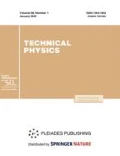Abstract
One of the challenging problems for mining enterprises, namely, predicting the decrease in the strength of the structure elements in guarded buildings and constructions during blasting, is solved in terms of a stress concentration factor, the time of exceeding the long-term tensile strength, and the crack growth rate. It is shown that the existence of stress concentrators in the form of natural heterogeneities or defects in the building materials of the building elements subjected to the action of seismic explosion and air shock waves results in crack growth. The distribution of cracks in samples of some materials and the ultimate tensile strength of these materials are determined to find the surface energy. The size distribution of cracks is used to calculate the effective crack length.
Similar content being viewed by others
References
G. A. Sobolev and A. V. Ponomarev, Fiz. Zemli, No. 10, 48 (2011).
V. S. Kuksenko, Kh. F. Makhmudov, V. A. Mansurov, U. Sultonov and M. Z. Rustamova, Fiz.-Tekh. Probl. Razrab. Polezn. Iskop., No. 4, 55 (2009).
A. Carpinteri, J. Xu, G. Lacidogna, and A. Manuello, Cem. Concr. Comp. 34, 529 (2012).
M. A. Sadovskii and G. A. Sobolev, Physical Foundation of Rock-Burst Prediction on Earthquake (Nauka, Moscow, 1987), p. 125.
M. G. Menzhulin, Kh. F. Makhmudov, and I. P. Shcherbakov, in Science Today: Theory, Practice, and Innovation (Nauchnoe Sotrudnichestvo, Rostov-on-Don, 2014), pp. 159–187.
A. M. Gul’el’mi, O. D. Zotov, and A. D. Zav’yalov, Fiz. Zemli, No. 1, 66 (2014).
M. G. Menzhulin, Kh. F. Makhmudov, V. S. Kuksenko, and U. Sultonov, Vestn. Tambovsk. Univ., Ser. Estestv. Tekh. Nauki 18, 1667 (2013).
Kh. F. Makhmudov, V. S. Kuksenko, N. G. Tomilin, and A. V. Benin, Vestn. Tambovsk. Univ., Ser. Estestv. Tekh. Nauki 18, 1909 (2013).
M. Pigeon, G. Toma, A. Delagrave, J. Marchand, B. Bissonnette, and J. C. Prince, “Equipment for the analysis and behavior of concrete under restrained shrinkage at early-ages,” J. Concr. Res. 52, 297 (2000).
J. H. Moon and W. J. Weiss, “Estimating residual stress in restrained ring test under circumferential drying,” J. Cem. Concr. Comp. 28, 486 (2006).
J. M. Sancho, J. Planas, D. A. Cendon, E. Reyes, and J. C. Galvez, Eng. Fract. Mech. 74, 75 (2007).
J. M. Sancho, J. Planas, A. M. Fathy, J. C. Galvez, and D. A. Cendon, Int. J. Numer. Anal. Meth. Geomech. 31, 173 (2007).
A. V. Benin, Deformation and Fracture of Ferroconcrete: Analytical, Numerical, and Experimental Research (GUPS, St. Petersburg, 2006).
Ju Gang Luo, et al., Appl. Mech. Mater. 188 (2012).
V. S. Kuksenko, N. G. Tomilin, Kh. F. Makhmudov, and A. V. Benin, Tech. Phys. Lett. 33, 62 (2007).
A. V. Benin, A. S. Semenov, and S. G. Semenov, Adv. Mater. Res. 831, 364 (2013).
A. P. Surzhikov and T. V. Fursa, Tech. Phys. 53, 462 (2008).
D. A. Fifolt, V. F. Petrenko, and E. M. Schulson, Philos. Mag. B 67, 289 (1993).
A. V. Benin, Seismostoikoe Stroitelstvo Bezopasnykh Sooruzhenii, No. 3, 16 (2007).
Kai Lai Deng, et al., Appl. Mech. Mater. 188 (2012).
V. S. Kuksenko, Kh. F. Makhmudov, and B. Ts. Manzhikov, Fiz.-Tekh. Probl. Razrab. Polezn. Iskop., No. 4, 29 (2010).
R. V. Gol’dshtein and V. M. Yentov, Qualitative Methods in Mechanics of Continuos Media (Nauka, Moscow, 1989).
E. B. Zavoichinskaya and I. A. Kiiko, Introduction to Theory of Solid Fracture: Tutorial (MGU, Moscow, 2004).
D. Broek, Foundation of Fracture Mechanics (Vysshaya Shkola, Moscow, 1980).
A. M. Leksovskii, G. N. Gubanova, V. E. Yudin, and B. L. Baskin, Tech. Phys. 58, 896 (2013).
A. A. Kozhushko and A. B. Sinani, Phys. Solid State 47, 836 (2005).
A. M. Leksowskij, V. A. Borovikov, N. S. Bozorov, A. A. Abdumanonov, A. B. Sinani, and S. A. Piletski, Tech. Phys. Lett. 28, 705 (2002).
V. V. Panasyuk, Limit Equilibrium of Cracked Brittle Solids (Naukova Dumka, Kyiv, 1968).
V. Z. Parton, Fracture Mechanics: From Theory to Practice (Gordon and Breach, Philadelphia, 1992).
V. Z. Parton and E. M. Morozov, Elastic–Plastic Fracture Mechanics (Mir, Moscow, 1978).
N. P. Kobelev, Ya. M. Soifer, A. F. Gurov, S. P. Nikanorov, A. B. Sinani, R. DeBatist, and J. Van Humbeeck, Phys. Solid State 44, 82 (2002).
A. M. Leksowskij and B. L. Baskin, Phys. Solid State 53, 1223 (2011).
K. R. E. Hellan, Introduction to Fracture Mechanics (McGraw-Hill, New York, 1984).
R. W. Hertzberg, Deformation and Fracture Mechanics of Engineering Materials (Wiley, New York, 2012).
G. P. Cherepanov, Mechanics of Brittle Fracture (McGraw-Hill, New York–London, 1979).
M. V. Zakharyan, “Prediction of decrease element strength of construction under action of blast load on building,” Candidate’s Dissertation (St. Petersburg, 2011), p. 20.
Kh. F. Makhmudov, Deform. Razrush. Mater., No. 8, 41 (2012).
L. R. Betterman, C. Ouyang, and S. P. Shah, “Fiber- Matrix interaction in microfiber-reinforced mortar,” Adv. Cement Based Mater., No. 3, 53 (1995).
V. C. Li, S. Wang, and C. Wu, “Tensile strain-hardening behavior of PVA-ECC,” ACI Mater. J. 98, 483 (2001).
O. Kentaro and O. Masayasu, Constr. Building Mater. 24, 2339 (2010).
V. S. Kuksenko, Kh. F. Makhmudov, M. D. Il’inov, and Z. M. Abdurakhmonov, Vestn. Inzh. Shkoly Dal’nevostochn. Federal. Univ., No. 3 (20), 98 (2014).
A. A. Kozyrev, V. I. Panin, S. N. Savchenko, et al., Seismicity at Mine Works, Ed. by N. N. Mel’nikov (Kol’sk. Nauch. Tsentr RAN, Apatity, 2002), p. 326.
M. G. Menzhulin, Kh. F. Makhmudov, I. P. Shcherbakov (Lambert Academic, 2014), p. 68.
Author information
Authors and Affiliations
Corresponding author
Additional information
Original Russian Text © Kh.F. Makhmudov, M.G. Menzhulin, M.V. Zakharyan, U. Sultonov, Z.M. Abdurakhmanov, 2015, published in Zhurnal Tekhnicheskoi Fiziki, 2015, Vol. 60, No. 11, pp. 79–85.
Rights and permissions
About this article
Cite this article
Makhmudov, K.F., Menzhulin, M.G., Zakharyan, M.V. et al. Diagnostics of the loss of stability of loaded constructions and the development of the sites of breakdown during the action of seismic explosion and air shock waves. Tech. Phys. 60, 1651–1657 (2015). https://doi.org/10.1134/S1063784215110201
Received:
Accepted:
Published:
Issue Date:
DOI: https://doi.org/10.1134/S1063784215110201




